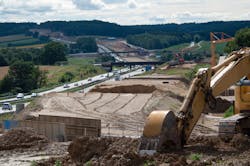The road trips we used to take as a family when I was a kid, whether to Florida or Maine, were inevitably surrounded by great memories that lasted a lifetime. In that regard, I must reference the adage by Ralph Waldo Emerson to describe the recollection of those long family jaunts: “Life is a journey, not a destination.”
With that being said, after a long and often contentious journey toward an infrastructure bill, the time has finally arrived. Our industry now has the new Infrastructure Investment and Jobs Act, which will provide a much-deserved, first-class office space for our professional truck drivers.
At times, it seemed as if a replacement to the FAST Act would never happen, with talks, debates, and campaign promises falling by the wayside. Faced with yet another expiring continuing resolution, the House finally moved on infrastructure language that devotes about $550 billion in new money to upgrade our nation’s deteriorating roads and bridges. As a campaign issue dating as far back as the 2016 election, we finally have a package that can make the necessary improvements to an infrastructure system that desperately needs it.
Of course, it isn’t only dollars that make this package worthwhile, either. On the heels of a massive supply chain crunch, the bill includes language pertaining to younger commercial motor vehicle drivers, exposing our industry as a viable career path in interstate commerce to prospective students who are seeking life after high school. All told, extolling the virtues of interstate commerce to a group that had been a previous afterthought is now more beneficial than ever before.
See also: Biden signs bipartisan infrastructure bill, paving way for transportation upgrades
Our professional truck drivers are already lauded as the safest, most well-trained drivers on the road today. This new demographic, ages 18-20 years old, will now be exposed to a curriculum that will make them even more skilled. Set to be effective in February 2022, the prospective new Entry Level Driver Training standard, coupled with the technological advancements of modern equipment, will now face a horizon of safety performance and efficiency that highlights what the future of trucking looks like. This should not be viewed as an immediate fix to the supply chain crunch that this nation is experiencing. In the long run, however, the infusion and exposure to new talent is certain to be an avenue that will aid in fighting the driver shortage in the future.
Trucking has long embraced the futuristic vision of safety, and the Infrastructure Investment and Jobs Act highlights that very notion. Incorporating language that advocates automatic emergency braking demonstrates the success of our industry in implementing this technology into its fleets. Requiring this equipment on all new trucks emphasizes our industry’s commitment to the prevention of crashes by focusing on what carriers have been doing for some time now--ordering this tech on new equipment and making the investment to create safer roadways.
Like any piece of legislation, the success is not just what appears in the bill but also what has been left out. Our industry had spoken loud and clear on the ramifications of the PRO Act and its threat to the independent contractor business model. Congress has heard our message and opted not to include any language that would have jeopardized a business practice that has a long history of success in building many of the large truckload carriers we see operating on the roads today. Let’s hope the congressional message resonates with the Supreme Court as the industry waits patiently to see whether our country’s highest court will actually hear the case regarding the much-maligned AB5 language out of California.
The message of this column is not one that celebrates the bill’s passage, but rather our industry’s involvement in moving it. Through the actions of TCA membership and the industry as a whole, the desire for funds to improve our nation’s roads and bridges has never been construed as a secret, and trucking has not been shy about telling it either. The success is not only in its passage but also in the passion that the industry had for getting this done. The ability to speak on multiple fronts has shown that trucking is willing to pick up the gauntlet.
The journey was certainly long and arduous, but the end result has finally justified the means.
About the Author
David Heller
David Heller is the senior vice president of safety and government affairs for the Truckload Carriers Association. Heller has worked for TCA since 2005, initially as director of safety, and most recently as the VP of government affairs. Before that, he spent seven years as manager of safety programs for American Trucking Associations.

